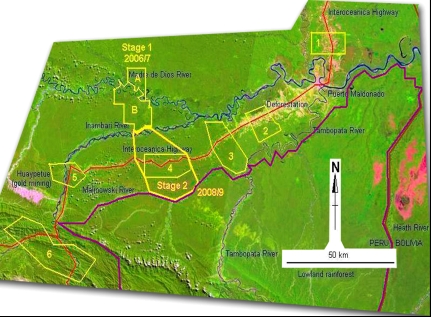|
Geoff Teigen
|
![[Go to CSUS Home Page]](gifs/csus_logo.jpg)
|
|
Geoff Teigen
|
![[Go to CSUS Home Page]](gifs/csus_logo.jpg)
|
Geoff joined the lab in the late fall of 2006.
Research: Will the Interoceanica Highway restrict gene flow in Amazonian Peru?: A study of Two Frog Species
Abstract:
While belief in the negative consequences of anthropogenic habitat fragmentation is abundant, empirical data to back up this idea are lacking with respect to the neotropics. Roads, and their associated infusions of humans, may rapidly divide habitat and restrict the dispersal of individuals between locales (Keller and Largiadèr 2003). The concept of landscape genetics provides a useful tool for evaluating the relative effects of distance and geographically distinct reproductive barriers (Manel et al. 2003). Advancements in molecular techniques and GIS technologies over the last two decades have allowed researchers to more accurately dissect the impacts that biotic and abiotic factors have on gene flow within taxa. We propose to utilize these techniques to examine the genetic impacts of highway development, and the resulting habitat fragmentation, on two species of neotropical anurans.
Relatively few studies in the tropics have examined the effects of geographic features on gene flow. Rivers, thought to pose significant barriers to dispersal in some taxa, have been shown to restrict significant migration in some species of frogs (Gascon, 1998). Fragmentation in general has been negatively correlated with both diversity and abundance in amphibians (Marsh & Pearman 1997). Despite this, Sumner et al. (2004) noted only limited effects of such degradation on a skink species.
The Tambopata region of Peru, situated in the southwestern corner of the Amazon basin, boasts some of the highest levels of biodiversity on the planet (Doan, 2002). The Transoceanic Highway, a dirt road, currently runs through this region. Major upgrades to the road, including paving, are imminent and will likely form a barrier to gene flow between the Tambopata-Candamo reserve zone and primary forests to the north.
Additionally, a bridge is currently under construction to the east, in Puerto Maldonaldo, that will span the Rio Madre de Dios. Completion of the bridge will facilitate immigration of people and subsequent habitat degradation in a region already under increasing anthropogenic pressures.
There is a strong possibility numerous taxa will be impacted by such development along the stretch of highway west of Puerto Maldonado to the Andean montane forests. The tremendously high variability of herpetofauna in the region (Doan, 2002) could become the first and most dramatic casualty of increasing habitat degradation. Anurans are an ideal target species for tracking such impacts due to their relatively low vagilities and short reproductive times.
The project will examine allelic variation within two species of anurans. The first, Bufo marinus (cane toad), while one of the most successful invasive species yet encountered, is indigenous to the Amazon basin. The second species, Physalaemus petersi, comes from the speciose family Leptodactylidae and ranges rather widely throughout rainforest habitat in Peru. Despite a glaring lack of microsatellite primers for neotropical anurans, we’re fortunate in that primer sets have been developed for both of our candidate species.
We will begin our field sampling in May 2007 in two1,000 hectare sites on each side of the road 25 km west of Puerto Maldonado. We will perform visual encounter surveys along 10 randomly chosen transects within each site. Five individuals of each species per transect will be collected and toe clips preserved in 95% ethanol will be kept for later DNA analysis. GIS coordinates will be recorded for each specimen.
Genetic analysis will be completed in Lima following a two month field collecting period. Extracted DNA will be amplified using separate sets of primers for each species. The amplified products will be identified through agarose gel electrophoresis and later analyzed for polymorphisms via a combination of single strand conformational polymorphism (SSCP) analysis and DNA sequencing. Genetic analysis will be completed by August 2008.
Data analysis will be completed by November 2008 and will consist of determining the number of alleles per locus, expected heterozygosities, departures from Hardy-Weinberg equilibrium, and any linkage disequilibrium. Mantel tests will be used to determine isolation-by-distance between individuals. We will examine genetic variance with F ST and then estimate the percentage of F ST variation, using partial Mantel tests, due to the highway and fragmentation.
Results of this study will be used as part of a larger ongoing effort to develop a forested corridor (Fig. 1) between the Tambopata area and a region of primary forests to the north. This is a unique opportunity to perform genetic analysis prior to the paving of a road that will become the main transport route through central South America.

Collaborators:
Regina Sara Nuñez Villalobos, M.Sc. Student in Environmental Development Pontificia Universidad Catolica del Peru
Chris Kirkby (Co PI) PhD Candidate, School of Biological Sciences, University of East Anglia (UEA), Norwich NR4 7TJ, United Kingdom
|
|
|